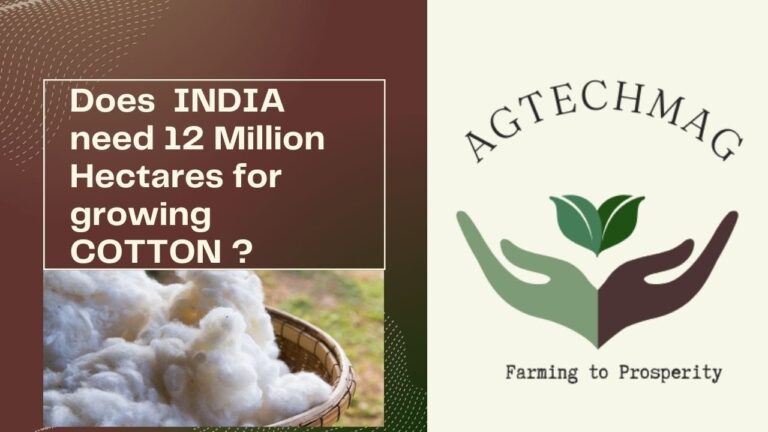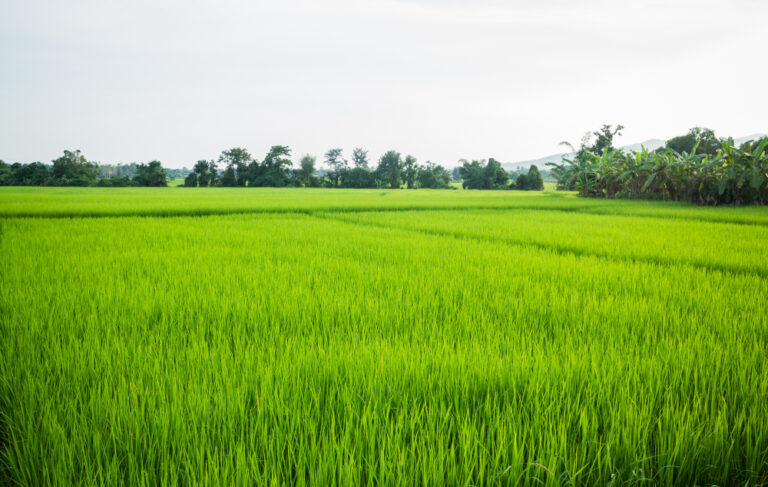Cotton is the most important fiber crop in the world and the largest commercial crop in India. Every year, nearly 6-7 million Indian farmers grow Cotton on a 12.5 million-hectare area, mostly during the Kharif or rainy season. Nearly 35%-50% of Cotton grown in India depends on monsoon rains and limited life-saving irrigations, making Cotton largely a rainfed crop in India, with its yields reliant on a well-distributed monsoon. Despite having the largest area of Cotton cultivation globally, India’s Cotton productivity is very low.
The average Cotton productivity in India is around 470 kg lint/ha, roughly equivalent to 1 bale per acre. This is significantly lower compared to other Cotton-growing countries worldwide. Another interesting fact is that Indian farmers have become accustomed to growing Cotton hybrids of Upland or American Cotton (Gossypium hirsutum) for the past 2-3 decades. Nearly 99% of Cotton grown in India comes from Hybrid Cotton seeds. The adoption of hybrid seeds is linked (i) to the risk mitigation behavior of the farmer under rainfed conditions, where hybrids can withstand vagaries of the monsoon and provide a minimum guaranteed yield, (ii) the availability of Genetically Modified (GM) crop transgenic technology only in Cotton hybrid seeds, enabling resistance to deadly Lepidopteran pests (Borer Caterpillars of Butterfly/Moth family), and (iii) the preference of the textile industry for long-staple Cotton.
“Cotton productivity isn’t just about yields; it’s about weaving a sustainable future for India’s agricultural landscape.”
Since the advent of GM Cotton in India in 2002, the only GM crop approved for large-scale cultivation in India, the area under Cotton hybrids has gradually increased from 50% to nearly 98%-99%. In other Cotton-growing countries like the USA, China, Australia, Turkey, Brazil, Pakistan, Uzbekistan, etc., Cotton varieties are grown widely instead of Cotton hybrids. Most of the varieties are grown at closer spacing, higher planting density, and higher seed rates compared to Cotton hybrids grown in India. Assured irrigation and suitable climatic conditions, including moderate temperature fluctuations and rainfall, in addition to large-scale landholdings for mechanized crop agronomic management, are some of the enabling factors for growing Cotton varieties in these countries. Consequently, the yield or productivity of Cotton per unit area in these countries is quite high compared to India. While India ranks first in terms of area and production, it ranks 42nd in the yield of Cotton. The below link from the International Cotton Advisory Committee (ICAC) shows the ranking of various Cotton-growing countries.
China, with 1844 kg lint/ha, has the highest yield in the world, compared to India’s 466 kg lint/ha in 2021-22. In terms of area, while India cultivates Cotton on 12.6 million ha, China cultivates 3.5 times more Cotton on 3.1 million ha. The global area of Cotton is 33.2 million ha. This paradox needs to be addressed on priority, and given the potential in R&D in Plant breeding, Biotechnology, Engineering, and other agricultural sciences, Indian Cotton yields can be at least doubled in the next 4-5 years by a systematic nationwide mission-mode program in a public-private partnership mode. This can free up at least 4-5 million ha of area, which can be used for other crops like pulses, oilseeds, and millets, suiting the agro-climatic or edaphic conditions of rainfed/dryland climate. Another major issue in Cotton in India is the shortage of labor, and nearly 40% of the cost of production is the labor cost, especially for picking (harvesting). This raises the need for mechanization at various stages of Cotton production, predominantly at picking or harvesting. To further summarize, the challenges and strategies to address them with respect to the Indian Cotton scenario are presented below.
Challenges and Strategies:
Need for Improved Cotton Varieties and Hybrids:
- Develop varieties with compact and open plant architecture and synchronous boll bursting to enable Cotton to be harvested in 1-2 pickings within the crop period of 150 days, thereby freeing up land for the next crop in Rabi or Winter season.
2. Cotton Hybrids and Varieties Suitable for High-Density Planting:
- Cotton Hybrid seeds are traditionally planted at 3’X3′, 3’X2′, or 4’X2′ (ft) in traditional Cotton-growing areas of North India (Punjab, Haryana, South Rajasthan), Western/Central India (Madhya Pradesh, Gujarat, Maharashtra), and South India (Telangana, Andhra Pradesh, Karnataka, and Tamil Nadu). In the last decade, Cotton has also been grown at closer spacing of 3’X1 ft’. With traditional wider spacing, only 5000-7000 plants per acre can be accommodated. However, with closer spacing of 3’X1′ and lower, such as 3′ X0.75′ (ft), nearly 12,500-18,000 plants per acre can be accommodated. This is moderate spacing compared to the ultra High-Density Planting System (HDPS) practiced in China, Brazil, the USA, and Australia.
3. Alignment with Textile Industry Requirements:
- Ensure that the choice of plant varieties grown by farmers aligns with the requirements of the textile industry. The Cotton produced in India is also not globally competitive due to various reasons, including the lack of alignment between fiber quality required by the industry and the seeds of plant varieties chosen by the farmer.
4. Adoption of Advanced GM Technologies:
- While 99% of Cotton grown in India is GM Cotton with the Bt (Bacillus thuringiensis) gene, new GM technologies and advancements in Biotechnologies, including Gene Editing/Genetic transformation, should also address challenges leading to yield losses like biotic stresses (diseases, competition from weeds, etc.) and abiotic stresses (Drought, Salinity, etc.). The existing Bt gene technology has become susceptible to certain pests like Pink Bollworm, which it is supposed to protect from; therefore, there is a need for more robust stacked gene technologies and other holistic measures to improve Cotton productivity.
5. Cotton Mechanization:
- Cotton mechanization is a critical requirement that can transform the entire industry. For mechanization to happen, the Government has to provide regulatory approval for certain harvest aids such as Defoliants, which have hazardous effects on the environment and health. While large-scale mechanization is possible with large holdings of more than 100 ha, the challenge is to customize the machinery and use harvest aids for Indian smallholder farms with an average land area between 2-4 ha.
6. Agronomic Practices Standardization:
- Review and standardize agronomic practices, including improving soil health through the addition of organic matter, implementing drip/micro-irrigation and mulching, and managing the transition from the vegetative growth stage to reproductive (flowering and boll setting) stages in Cotton. Plant growth regulation using growth regulators and topping is also an important intervention.
7. Biomass Utilization and Carbon Credits:
- Utilize Cotton plants’ biomass after harvest, which is often burnt for land preparation, to reduce emissions. In most Cotton areas in India, only one crop is grown, and the land is left fallow until the next monsoon. Cotton stalks can be plowed back as mulch into the soil, and Cotton stalks can be converted into “Biocharcoal,” and Biocharcoal-based biocompost can be prepared and applied to the soil to improve soil health. This also makes Cotton farms eligible for claiming Carbon credits.
8. Procurement and Ginning Process:
- Regarding the procurement of Kapas (raw seed Cotton), there is no strong alignment between paying a premium for Cotton with superior fiber quality parameters. As farmers grow 2-3 Cotton varieties, often with divergent fiber quality parameters, while aggregating produce, the length uniformity index is low (75%-80%), and other fiber quality parameters like micronaire (lustre), fiber strength, Rd (Degree of Reflectance) are also mixed up. Therefore, there is a need to grow varieties of uniform fiber quality surrounding ginning units and textile mills to enable segregated aggregation of Cotton of superior fiber quality and ensure global competitiveness of Indian Cotton.
9. Upgrading Ginning Mills and Processing Infrastructure:
- There is a strong need to equip Ginning mills and other downstream processing infrastructure, such as small and large-scale pre-cleaner equipment, to develop capabilities to produce clean, contamination-free, low trash Cotton, thereby making it globally competitive.
10. Enhancing Credibility of Organic Cotton: – India also has the largest Organic Cotton growing area in the world; however, the credibility of Indian Organic Cotton in global markets can be improved further by developing strong traceability and compliance systems over blockchain to fetch a premium for Indian Cotton in global markets.
11. Holistic R&D Focus: – Indian R&D in both the private and public sectors should also focus on the development of the Cotton value chain in a holistic mode in synergy with the Textile industry. This should include the development of sustainable agronomic practices, new plant varieties with superior fiber quality, tolerance to biotic/abiotic stresses, and high adaptability.
When all the above pieces fit together in a mission mode, India can leap ahead in 4-5 years and can be at least in the top 20 in the global ranking table. That certainly will have a great impact on the Indian agrarian economy.




